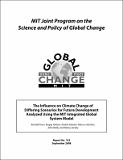| dc.contributor.author | Prinn, Ronald G. | |
| dc.contributor.author | Paltsev, Sergey | |
| dc.contributor.author | Sokolov, Andrei P. | |
| dc.contributor.author | Sarofim, Marcus C. | |
| dc.contributor.author | Reilly, John M. | |
| dc.contributor.author | Jacoby, Henry D. | |
| dc.date.accessioned | 2009-02-23T16:30:53Z | |
| dc.date.available | 2009-02-23T16:30:53Z | |
| dc.date.issued | 2008-09 | |
| dc.identifier.uri | http://globalchange.mit.edu/pubs/abstract.php?publication_id=938 | |
| dc.identifier.uri | http://hdl.handle.net/1721.1/44621 | |
| dc.description | Abstract and PDF report are also available on the MIT Joint Program on the Science and Policy of Global Change website (http://globalchange.mit.edu/). | en |
| dc.description.abstract | A wide variety of scenarios for future development have played significant roles in climate policy discussions. This paper presents projections of greenhouse gas (GHG) concentrations, sea level rise due to thermal expansion and glacial melt, oceanic acidity, and global mean temperature increases computed with the MIT Integrated Global Systems Model (IGSM) using scenarios for 21st century emissions developed by three different groups: intergovernmental (represented by the Intergovernmental Panel on Climate Change), government (represented by the U.S. government Climate Change Science Program) and industry (represented by Royal Dutch Shell plc). In all these scenarios the climate system undergoes substantial changes. By 2100, the CO2 concentration ranges from 470 to 1020 ppm compared to a 2000 level of 365 ppm, the CO2-equivalent concentration of all greenhouse gases ranges from 550 to 1780 ppm in comparison to a 2000 level of 415 ppm, sea level rises by 24 to 56 cm relative to 2000 due to thermal expansion and glacial melt, oceanic acidity changes from a current pH of around 8 to a range from 7.63 to 7.91. The global mean temperature increases by 1.8 to 7.0 degrees C relative to 2000. | en |
| dc.description.sponsorship | The IGSM model used here is supported by the U.S. Department of Energy, U.S. Environmental Protection Agency, U.S. National Science Foundation, U.S. National Aeronautics and Space Administration, U.S. National Oceanographic and Atmospheric Administration and the Industry and Foundation Sponsors of the MIT Joint Program on the Science and Policy of Global Change. | en |
| dc.language.iso | en_US | en |
| dc.publisher | MIT Joint Program on the Science and Policy of Global Change | en |
| dc.relation.ispartofseries | ;Report no. 163 | |
| dc.title | The Influence on Climate Change of Differing Scenarios for Future Development Analyzed Using the MIT Integrated Global System Model | en |
| dc.type | Technical Report | en |
| dc.identifier.citation | Report no. 163 | en |
